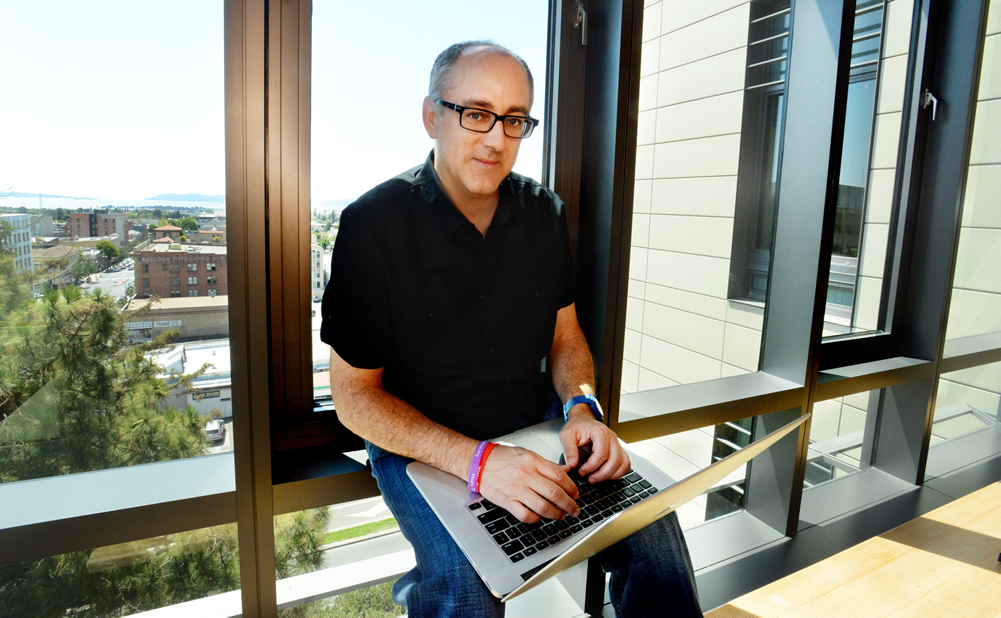Fishing for a Cure
The brain seizures begin in infancy — severe electrical misfirings that trigger half-hour traumas of jerks and spasms. By age two, development stalls, leaving profound intellectual deficits, chronic infections, hyperactivity and an increased likelihood of autistic-like behavior.
Dravet syndrome is the most common of about a dozen “catastrophic epilepsies of childhood,” each affecting one in 30 to 50,000 children. Many are caused by specific gene defects that disrupt communication between neurons. None have cures.

Over the past two years, UCSF neuroscientist Scott Baraban has screened more than 1,300 drugs in animals hobbled by the Dravet mutation and the seizures it causes. Last year, he discovered a drug that stopped seizures in these animals. The drug, called clemizole, is an antihistamine used mainly in the 1950s to treat allergies. Preliminary results hint that clemizole may become the first drug to treat the devastating childhood epilepsy.
Baraban came to UC Berkeley this spring to greatly extend these studies. Working with UC Berkeley bioengineer Luke Lee, he is adapting a technology called microfluidics to launch a much larger-scale screening strategy, in search of drugs that might protect against all of the varied genetic forms of childhood epilepsy.
He is also teaming up with Berkeley neuroscientist Ehud Isacoff in more basic research examining the brain networks that trigger epilepsy and how seizures progress from neuron to neuron. And with biologist Daniela Kaufer, they are trying to tease apart other puzzles about how brain mechanisms either propel or defend against epileptic seizures.
The research partnership is made possible by the Sackler Sabbatical Exchange Program that brings UCSF scientists to UC Berkeley and vice versa so the researchers can share techniques and insights. The aim is to accelerate progress in basic and clinical research on both campuses.
“The Sackler sabbatical offers me a great opportunity to work with UC Berkeley scientists,” Baraban says. “We have common interests but different skills. Our research at UCSF is usually clinically oriented, and Berkeley scientists are superb at basic neuroscience research on processes underlying brain function, so it’s a win-win situation when we collaborate.”
Baraban’s research employs a tiny creature, silvery freshwater minnows known as zebrafish. The entire genome of the zebrafish has been sequenced. At least 70 percent of human genes have a counterpart in the inch-long fish, including genes that cause childhood epilepsies.

As small as they are, adult zebrafish are giants compared to the eyelashsized larval stage that Baraban studies. At UCSF, he was able to mimic Dravet syndrome in zebrafish larvae by using a mutant with a defect similar to that found in humans. He then bred thousands of the fish with the epilepsy defect. In lab experiments, he isolated individual larvae with the epilepsy gene mutation in tiny water-filled wells and introduced different drugs into the wells.
The procedure employed a tracking protocol developed in his lab that allows a rapid, automated drug screen against seizure behaviors. With this approach, his UCSF lab determined that clemizole — unique among more than 1,300 drugs he tested — stopped the spasmodic epileptic behavior. The finding, also confirmed in electrical recordings from individual larvae, resulted in a widely discussed paper in the journal Nature Communications.
But to search for drugs that might protect against all the types of genetic epilepsy requires an even more efficient approach. Luke Lee is devising a strategy he calls a “integrated zebrafish activity platform or iZAP” that allows drugs to be rapidly screened based on electrical brain activity (seizures) — not only behavior.
In the microfluidics apparatus, the fish will float into tiny chambers where electrodes will be used to record brain seizures while drugs, easily dissolved in the fish water, can be tested for their ability to stop these electrical “misfirings.” In contrast to previous work where only one zebrafish could be monitored at a time, this microfluidics platform will allow simultaneous micro-EEG recordings from hundreds of fish.
In his collaboration with Ehud Isacoff, Baraban will exploit a startling new technology developed at Janelia Farms, part of the Howard Hughes Research Institute. The strategy allows researchers to observe electrical neuronal activity in the whole brain of a living zebrafish larvae. The feat is made possible by genetically encoding the neurons so that they emit a detectable signal when internal calcium levels in the neuron rise — a crucial step in normal neuron firing.
With this real-time technique, neuronal activity shows up as pinpoints of flashing light, easily seen because the larvae exhibit — literally — a novel trait: they are transparent.
“We can literally watch brain activity in live zebrafish,” Baraban says. “We hope to study the neural networks that generate epileptic seizures in the fish. “Teaming up with Luke and with Udi (Isacoff) is very exciting. I hope this opportunity to do hands-on experiments in their labs will be the start of years of collaboration.”
At UCSF, Baraban holds the William K. Bowes Jr. Endowed Chair in Neuroscience Research and is a professor of neurological surgery.
The Raymond and Beverly Sackler Center for Biomedical, Physical and Engineering Sciences rewards innovative research approaches that take advantage of and promote the convergence of the biomedical, physical and engineering fields encouraging scientists to move into new fields and cross into other areas of convergence in order to realize the full potential for achieving transformative scientific breakthroughs. To advance this fertile research area, the Center facilitates innovation and faculty collaboration between UC Berkeley and UCSF through a prestigious sabbatical exchange program. For more information about the Sackler Center, please visit sackler.berkeley.edu
